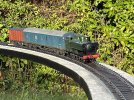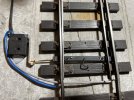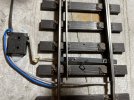andrew60
Member
After cutting and aligning, the long section of plain line was connected up with a bus wire and droppers well soldered to the undersides of each of the approx 6ft rail lengths (these are connected with plastic rail joiners). Holes were drilled through the concrete for the droppers, to avoid unsightly straggly bits of wire on the surface, then time for a first test.....part-finished Druid did the honours, complete with magnificently earthy sound chip. Ignore the colours - Youtube's algorithms seem to think Warships should be painted luminous pink with Dayglo ends:
Turning my attention to the colour of the track, I was aware that what works indoors probably won't in the garden, so not a simple matter of a quick spray with Railmatch track colour. Neither was hand painting an option given the lengths involved. Long story short, after several experiments and blind alleys I settled on the application of three layers: Upol Acid8 etch primer as a base, followed by Halfords outdoor Camouflage Brown. This looks more 'Lindt chocolate selection' than 'rusty rail sides' so the third layer was a light pass of Molotow Orange Brown (graffiti art). Overlaying one colour with another often produces a pleasing effect, and a slightly translucent quality. It all sounds a bit of a faff, but each layer is very quick drying, and as with all spraying, it's the masking which takes the time, and the actual painting is very quick.
 Masking up to leave the rail sides and chairs exposed on one side, but with both rails dealt with at the same time.
Masking up to leave the rail sides and chairs exposed on one side, but with both rails dealt with at the same time.

After spraying the etch primer and brown on one side and before the orange-brown overspray which produced a pleasing rust tint. Any slight unevenness is fine, reflecting variations in the real thing. On the visible sections, the process was repeated from the other side.

I was pleased with the result - just needs ballast now.
Turning my attention to the colour of the track, I was aware that what works indoors probably won't in the garden, so not a simple matter of a quick spray with Railmatch track colour. Neither was hand painting an option given the lengths involved. Long story short, after several experiments and blind alleys I settled on the application of three layers: Upol Acid8 etch primer as a base, followed by Halfords outdoor Camouflage Brown. This looks more 'Lindt chocolate selection' than 'rusty rail sides' so the third layer was a light pass of Molotow Orange Brown (graffiti art). Overlaying one colour with another often produces a pleasing effect, and a slightly translucent quality. It all sounds a bit of a faff, but each layer is very quick drying, and as with all spraying, it's the masking which takes the time, and the actual painting is very quick.
 Masking up to leave the rail sides and chairs exposed on one side, but with both rails dealt with at the same time.
Masking up to leave the rail sides and chairs exposed on one side, but with both rails dealt with at the same time.
After spraying the etch primer and brown on one side and before the orange-brown overspray which produced a pleasing rust tint. Any slight unevenness is fine, reflecting variations in the real thing. On the visible sections, the process was repeated from the other side.

I was pleased with the result - just needs ballast now.





 'Bulldog' will have to do instead for fans of esoteric hydraulics....
'Bulldog' will have to do instead for fans of esoteric hydraulics....

 I feel the need for guidance from a certain Association....
I feel the need for guidance from a certain Association....




